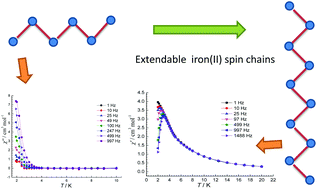Dynamic magnetism of an iron(ii)-chlorido spin chain and its hexametallic segment†
Abstract
An air-stable iron(II) chain compound [Fe(phen)(Cl)2]n (1, phen = 1,10-phenanthroline) was prepared and exhibits intrachain ferromagnetic interactions as well as competing interchain antiferromagnetic interactions that are mediated by π–π stacking of the phen ligands, resulting in metamagnetic behaviour. The interchain interactions can be altered by changing the external magnetic field, and disparate magnetic dynamics was thus observed from zero to the critical field of 1500 Oe. Zero-field cooled (ZFC) and field-cooled (FC) magnetization and heat capacity measurements indicate that long-range antiferromagnetic ordering occurs at lower fields, and this ordering disappears when the external field is larger than 1500 Oe. The low-frequency ac susceptibility data are consistent with the exponential increase of the temperature-dependent dc data, indicating a Glauber-type dynamics under the field of 1500 Oe. Thus, 1 is considered as a metamagnetic single-chain magnet. For further analysis, a discrete hexametallic segment of the chain, [Fe6(phen)6(Cl)12] (2), was also isolated and was shown to possess a high-spin ground state and display slow magnetic relaxations like single-molecule magnets. Magnetic analysis using CONDON suggests weak ferromagnetic interactions between the metal centres. The polymeric compound 1 can be viewed as being constructed using the hexametallic unit 2 which is of a low energy barrier, suggesting the significance of intrachain ferromagnetic interactions in enhancing the spin-reversal energy barrier of the short chains.



 Please wait while we load your content...
Please wait while we load your content...